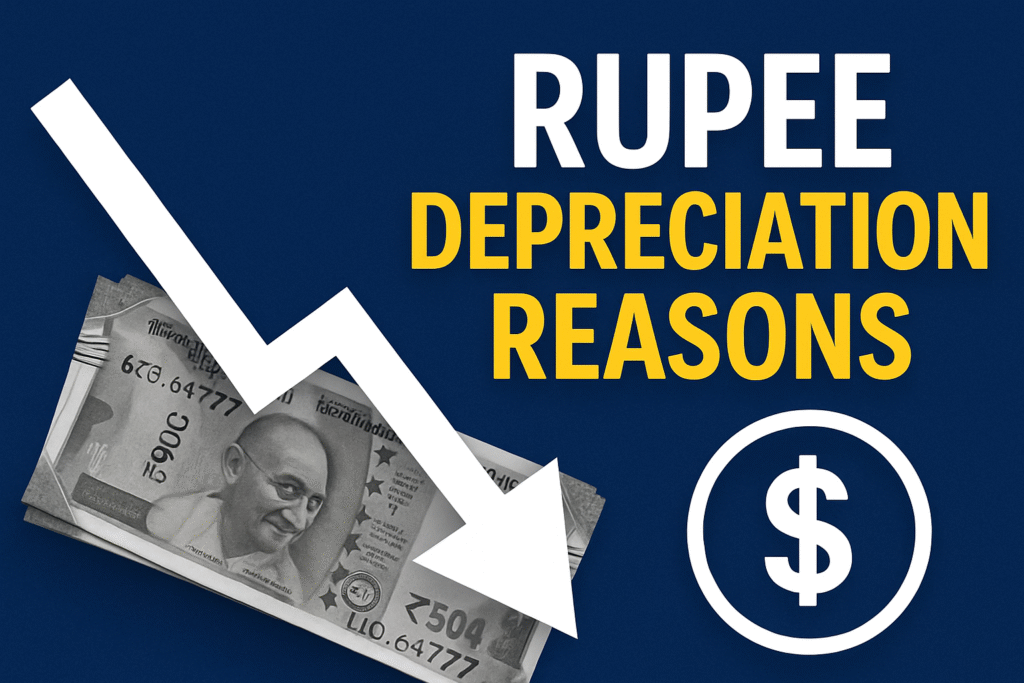
Top 5 Reasons Behind Rupee Depreciation: Explained Simply
“The rupee has fallen again against the dollar.” You’ve probably heard this in the news quite often. But have you ever wondered what actually causes the Indian rupee to lose its value?
In this article, I’ll break it down for you in simple, practical language — just like a conversation with a finance-savvy friend.
We’ll cover:
- What rupee depreciation means
- Top causes behind it
- How it affects your wallet
- What can be done to control it
What Does Rupee Depreciation Actually Mean?
When we say the rupee has depreciated, we mean that it now takes more rupees to buy 1 US dollar.
For example:
- Earlier: 1 USD = ₹74
- Now: 1 USD = ₹84
This means the rupee has weakened or lost value — also known as rupee depreciation.
Top 5 Reasons Why the Rupee Falls
1. Fall in Foreign Investments (FII Outflows)
When foreign institutional investors (FIIs) pull their money out of Indian markets, they convert their rupees to dollars. This increases demand for the dollar and puts pressure on the rupee.
This often happens when:
- Interest rates rise in the US
- Global investors move towards safer assets like gold or USD
2. Higher Imports Than Exports
India imports more than it exports — especially crude oil, electronics, and machinery. More imports mean more dollars going out, which reduces the rupee’s value.
On the other hand, if exports lag behind, dollar inflow is less, making the currency imbalance worse.
3. Rising Crude Oil Prices
India imports over 80% of its oil. When global oil prices rise:
- India pays more dollars
- Trade deficit increases
- Rupee depreciates further
4. RBI’s Currency Management Policies
Sometimes, the Reserve Bank of India (RBI) allows the rupee to weaken slightly to help Indian exporters, as a weaker rupee makes Indian goods cheaper for foreign buyers.
However, if the rupee falls too sharply, the RBI steps in and sells dollars from its forex reserves to stabilize the currency.
5. Geopolitical Uncertainty and Global Events
Events like the Russia-Ukraine war, Middle East tensions, or fears of a global recession can shake investor confidence. In such times, investors rush to the dollar, which is seen as a ‘safe haven’, causing the rupee to fall.

How Does Rupee Depreciation Affect You?
You may not be a trader or economist, but the falling rupee impacts everyone:
- Imported goods become expensive — like electronics, phones, and fuel
- Foreign education costs rise
- International travel gets costlier
- Inflation may increase, making daily life more expensive
Can the Rupee Be Strengthened?
Yes, the rupee can be stabilized and even strengthened with the right policies:
- Boosting exports with better infrastructure and incentives
- Attracting long-term foreign investment
- Reducing oil dependency by supporting electric vehicles and alternative energy
- Maintaining stable fiscal and monetary policies
Final Thoughts: Why You Should Care About the Falling Rupee
The rupee’s value is not just an economic term — it has real effects on your expenses, savings, and lifestyle.
By understanding its causes, you can make smarter financial decisions — whether you’re planning a trip abroad, investing in foreign assets, or simply budgeting your monthly expenses.
📢 What Do You Think?
Do you think the Indian government is doing enough to control rupee depreciation?
💬 Share your thoughts in the comments below
🔗 For more personal finance insights, visit our Finance Blog Section.
🔁 Share this post if you found it useful!

